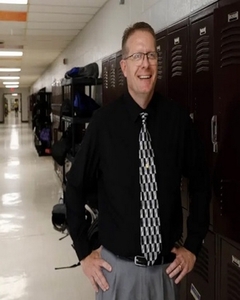When David Vinson became superintendent of Warner Public Schools in 2012, the district’s schools had a “C” rating on Oklahoma’s state report card. Since that time, Warner’s schools have excelled academically, routinely receiving “A” grades for performance. In this feature, Vinson shares his keys to success.
I grew up in Northeast Oklahoma where I had the privilege of attending three excellent public schools: Wagoner, Sapulpa, and Chouteau. After high school, I earned my teaching degree and landed my first position in Checotah where I served as a teacher, a coach, and an elementary school principal. Later, as principal of Vian High School, I worked alongside excellent teachers and staff to earn a 4.0 rating—an “A” grade—on the state report card.
In 2012, I began my tenure as Superintendent of Warner Public Schools. In my first year, our elementary and high school received “C” grades. Our teachers and staff made key changes the following year that raised Warner’s performance. Since 2013, our students have consistently been in the top 10% for academic achievement in Oklahoma. This year’s graduating class had an average ACT score of 21, which is four points higher than the state average and about on par with the average for Massachusetts – our nation’s highest performing state. Since 2012, we have had 20 students get an ACT score of 30+. This number is substantial for a high school with an average graduating class size of just 43 students.
Keys to Success at Warner
Some may wonder what is behind Warner’s success. My response is that simplicity is key. Too often leaders overcomplicate school improvement. My philosophy of school leadership is grounded in attention to the basics and common sense with an emphasis on structure, discipline, and high expectations. I have found that this approach creates the conditions for teachers to deliver the high-quality education that our students deserve. But what does this look like on the ground? The following are practical approaches that I tie to Warner’s success. I am confident that these are strategies that other schools in the state can use to raise their own academic performance.
1. Own the Need to Improve
The A-F Report Card system is not perfect. However, it can and should be used as a tool to improve educational outcomes. If a school is low on academic performance, growth, or attendance, information from the school report card can help to catalyze change, but it starts by first acknowledging that improvement is needed. When I started at Warner thirteen years ago, we received a “C” rating. To respond, my first action was to send a letter to our families owning the C grades and letting our community know that a “C” grade was unacceptable. We stressed that our teachers and staff were already hard at work to improve our district’s future school grades and student performance.
By making it clear that everyone in the school community could and should do better, the expectation level was immediately raised for administrators, support staff, teachers, and students. Second, we had to eliminate the notion that a “silver bullet program” could solve our educational challenges. We did away with the “smoke and mirrors” and “things that just look good on paper” and got down to the meat of teaching and learning. We asked what we could do to instruct students at a high level in classrooms every day and how we could continuously improve. And, we regularly reminded ourselves to stop blaming society or any other external factors that we could not control – that blame was not solving anything.
2. Foster Structure and Discipline: Without Them, You Cannot Be Successful
To improve student achievement, there are simple behavioral policies leaders can use, but simple does not necessarily mean easy. It is difficult work to adhere to these policies consistently. When I started at Warner, we gave our teachers their classrooms back by raising standards for student behavior. That started with the creation of good old-fashioned structure, discipline, and respect. We also removed students’ personal devices (e.g., cell phones, tablets, smart watches). Our school does not allow cell phones during any part of the school day from 8 AM to 3 PM. This policy has been in place in our district for thirteen years and teachers are required to follow this policy. Simply put, we eliminated distractions from the classroom and demanded quality behavior, which allowed students to concentrate on learning.
Ultimately, we have a system of structure and discipline that emphasizes the little things. I often say that staying on top of the “little things” keeps the big things away. Class disruptions, dress code violations, tardiness, foul or immoral language are examples of the little things. As for the big things, we have zero tolerance policies that include lengthy student suspensions for fighting, drug/alcohol violations, vaping, disrespect towards teachers, and cell phone violations.
3. Use School Time Effectively
At Warner, teachers must be prepared to teach from bell to bell every day; we have established procedures to never waste a minute of class time. The focus of Warner’s classrooms is always on learning. We provide quality curriculum, teach the state-adopted standards, and monitor regularly so we know how individual students are progressing. For academically struggling students, our teachers show up before school, stay late after school, and forgo lunchtime to provide tutoring. Our expectation is that we will leave NO student behind.
To ensure efficient use of class time, every class period begins with a “bell ringer”. The bell ringer is a question to engage students academically as soon as the bell rings. While students are writing and answering the bell ringer, teachers take attendance and complete administrative tasks. Then, lessons are delivered and individual practice occurs. After a student is finished with individual work, that student is expected to continue learning by reading a library book, which limits disruptions and keeps the focus on learning. Every student must carry a library book to class. Additionally, every student in our district must read and attain a certain number of “Accelerated Reader” points to maintain their activity eligibility (along with maintaining solid grades and attendance for eligibility). In this way, students are held accountable for their own performance.
4. Get Students Involved with Enrichment and Extracurricular Opportunities
Involved students perform better academically because they have to maintain academic eligibility to participate in extracurricular activities. But more fundamentally, being involved in school activities fosters community, belonging, and a sense that one is part of a team that is greater than oneself. Over the years, we have transformed enrichment and extracurricular opportunities at Warner by launching wrestling, choir, art, Cherokee Academic Teams, leadership teams, video production, construction, and a high school racing team. Each of these programs provides an avenue for our students to pursue their own niche and become involved in campus life and community service.
5. Reward Outstanding Teacher Performance
Teachers are the most critical school-based resource when it comes to accelerating student achievement. To attract and retain high-quality teachers, we need to reward high-performing teachers with additional compensation. Paying extra for exceptional performance for teachers going above and beyond the norm is necessary in today’s educational and broader macroeconomic environment.
Several years ago, we began offering all of our staff members 5.5% of their teacher retirement contribution. Because teacher retirement takes 7.5% of everyone’s paycheck, we put a significant amount of money back into our teachers’ pockets by picking up about three-quarters of teachers’ monthly retirement contributions. This initiative kicks in once an employee has completed two successful years at Warner.
Two years ago, we expanded efforts to compensate exceptional teachers by implementing the Oklahoma Teacher Empowerment Program (OTEP). This program provides large pay increases ($7,500-$15,000 a year) for the top 10% of our teachers. This program has undeniably been a blessing for some of our most outstanding teachers, and I hope state legislators will broaden it in the future.
I have proposed to state legislators that “A” rated schools be allowed to recognize a higher percentage of teachers under the OTEP program. More than 10% of our teachers are high performing. To bridge this gap, we introduced our teacher incentive plan – the Warner Merit Pay Plan, which awards more of our high performing teachers with $2,000 annually.
6. Stay the Course
Most of our students and families love Warner, but our approach is not everyone’s cup of tea. Occasionally, someone expresses discontent with our high standards for student behavior and achievement. For example, there are some who would rather students have more liberties or an easy path to graduation. In such instances, it is essential to remember that this is perfectly fine. When you stress rigor and standards, you will inevitably have some detractors. For the 830+ students we have in Warner today, we are going to continue to provide excellent academic opportunities and a high quality education that is second to none for all of our students.
Embracing Accountability Statewide
Over the past decade, I have read numerous op-eds and listened to countless school leaders dismiss Oklahoma’s A-F School Report Cards as unfair, legislative overreach, and an inadequate “snapshot” of true performance. These arguments frustrate me. Too many school leaders refuse to accept that they can and should do better. Leaders have the resources at their disposal to make change within the hallways and classrooms of their schools in ways that would translate into higher letter grades, and more importantly, increased student performance and post-secondary success.
Oftentimes, leaders in Oklahoma pin low performance on district size, poverty, and racial/ethnic factors, but when I look at Oklahoma’s report cards, I see both large and small districts receiving “A” grades. I also see that “A” schools are remarkably diverse in their economic and racial makeup. Factors like school size, family income, and ethnic background should not be accepted as the cause of poor school performance. Others who lament that state tests are merely a “one day snapshot” and not truly reflective of school performance seem to forget that annual state tests show whether consistent progress is being made over time. For example, many “A” rated schools have performed well for over a decade on this so-called “snapshot”.
In my view, school leaders have devoted too much time and energy to bashing the “system”, but this has not improved the quality of education in our state at all. In fact, such attitudes have likely set us back. Instead, I ask school leaders to look at what “A” rated schools are doing and how they overcome challenges to achieve success. Successful school districts should also be celebrated more frequently so that others can learn what they are doing. It often feels as if school districts like ours have to downplay our success so others can continue with mediocrity and underperformance. I want to congratulate Warner’s students and families for achieving two of the sixty “A” grades in our state this past year. And, I am incredibly grateful to our teachers, staff, community, and school board for making this success possible.
I am certain that what we have done in Warner can be replicated elsewhere in Oklahoma. I implore our school leaders to dispense with excuses, embrace the need to improve, and raise academic and behavioral expectations for students. There are phenomenal teachers and students within every school across Oklahoma that are ready to make higher levels of school performance a reality.
Author Bio
David Vinson is Superintendent of Warner Public Schools. He has been an educator and school leader in Oklahoma for over 25 years.




